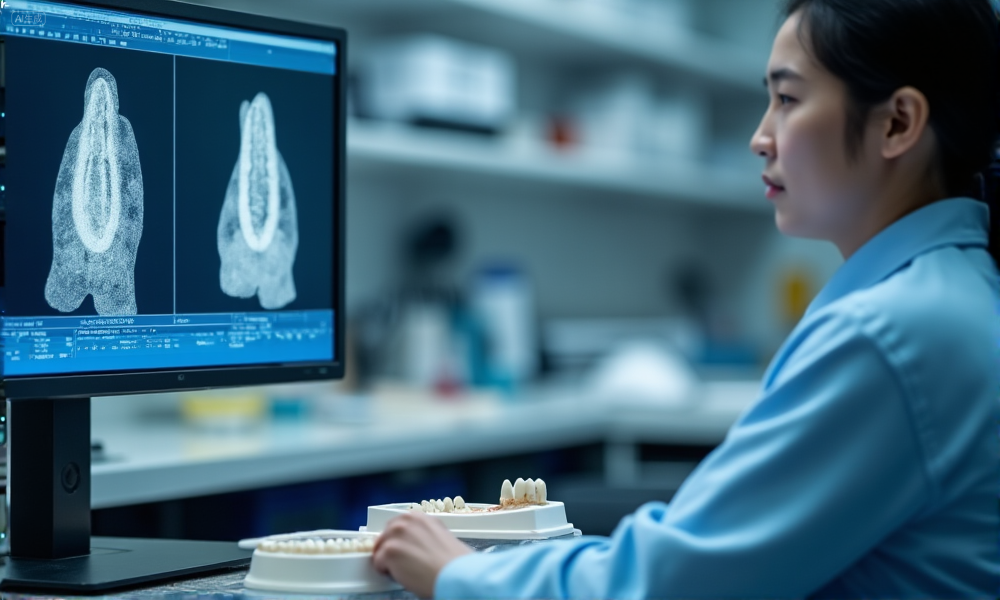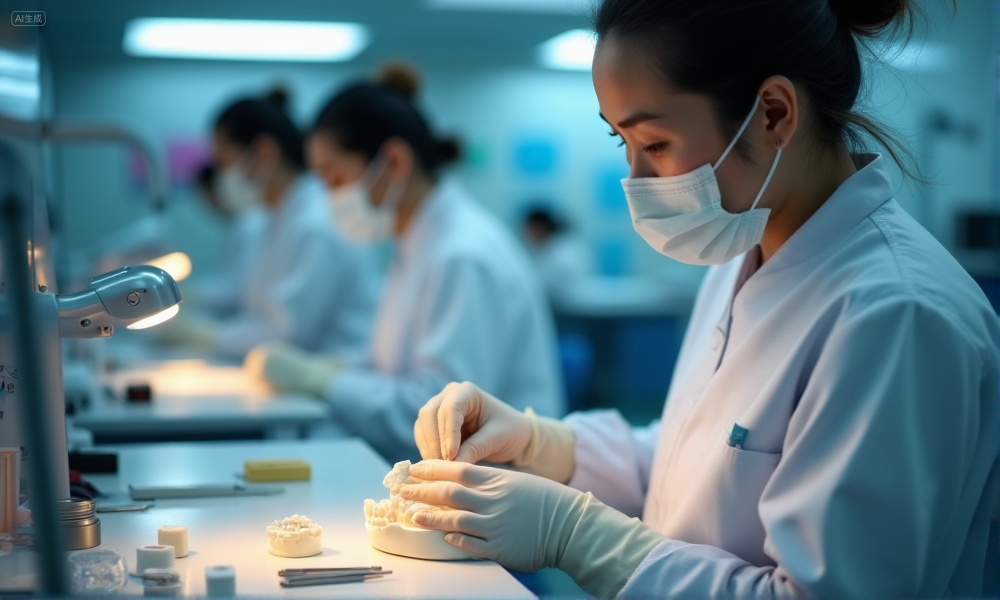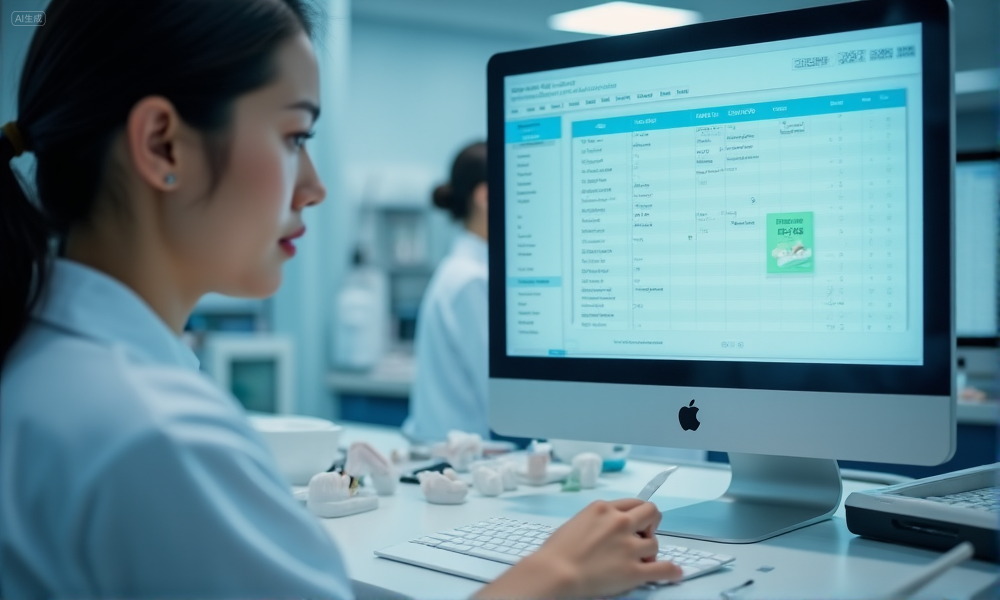In dental implant restorations, every day of delivery delay can cost a clinic hundreds of dollars in lost chair time and patient rescheduling—while also risking long-term trust. When outsourcing implant cases to overseas dental labs, turnaround and delivery time are shaped by a chain of interconnected factors. Procurement teams assessing potential partners must evaluate not only technical capabilities but also the efficiency of every stage—from case submission to final shipment. Delays often stem from inaccurate impressions, complex case designs, material shortages, or slow communication, while streamlined workflows and dependable logistics can significantly reduce lead times.
Key dimensions to evaluate include:
- Impression and scan quality – Precise digital scans minimize remakes and accelerate production.
- Case complexity – Multi-unit and full-arch restorations require longer timelines and careful planning.
- Material selection – Processing times and supply chain reliability vary by material.
- Communication efficiency – Complete submission files and prompt responses prevent bottlenecks.
- Logistics and customs – Courier choice, accurate documentation, and clearance speed directly affect delivery.
- Internal lab capacity – Skilled technicians and balanced workloads maintain consistent turnaround.
- Delivery commitments – Embedding turnaround metrics in SLAs creates shared accountability.
By addressing these variables during supplier selection and order planning, clinics and procurement teams can set realistic expectations, achieve dependable delivery schedules, and maintain consistent quality in implant case outcomes.
How Impression and Scan Quality Impacts Implant Case Turnaround
Accurate impressions and clean, complete digital scans directly shorten implant case turnaround by reducing remakes and minimizing clarification delays. Even the fastest overseas dental lab cannot offset errors captured at the source
A high-quality impression or scan is the foundation of efficient case delivery. For overseas dental labs, any distortion, missing margin detail, or incomplete digital dataset introduces extra verification steps. That can add days to production time—especially when time zone differences limit same-day feedback loops. Inconsistent quality from the clinic side often explains why identical cases have different delivery speeds.

Dental-lab-scan-quality-check
Why impression accuracy is critical for overseas lab delivery times
Minor inaccuracies in an impression can cause significant downstream delays. Labs may need to pause production to confirm unclear margins or implant positions, particularly for multi-unit cases. When working with an overseas partner, these clarification requests can result in 24–48 hours of idle time before adjustments begin. From our production floor experience, cases with first-pass accurate impressions typically finish 2–3 days faster than those requiring verification.
Digital scans vs. physical impressions: effect on lead time and remake rates
- Digital scans: Allow immediate transmission, skipping courier transit, and enable earlier problem detection. Average lead time savings: 1–2 days.
- Physical impressions: More prone to deformation during shipping, especially with long transit routes, and cannot be quality-checked until they arrive.
- Remake rates: Overseas labs report lower remake percentages with well-executed intraoral scans, as data can be cross-checked before milling or printing begins.
Best practices to ensure scan and impression quality before outsourcing abroad
- Check margins under magnification before sending files or packing trays.
- Include bite registrations and adjacent tooth details for occlusal accuracy.
- Use compatible file formats (e.g., STL, PLY) to avoid conversion errors.
- Stabilize physical impressions with rigid containers to prevent distortion in transit.
- Send a quick reference photo alongside digital files to help technicians verify context.
In our collaborations as an overseas dental lab, clinics that follow these steps not only shorten delivery time but also increase consistency across cases. The time saved at the start often outweighs any extra minutes spent on chairside verification.
How Case Complexity and Restoration Type Influence Production Schedules
Multi-unit and full-arch implant restorations typically require longer production timelines than single-unit cases because they demand more design steps, verification stages, and precision checks. Overseas dental labs must coordinate multiple technicians and extended milling or layering cycles, making case complexity one of the strongest predictors of turnaround time.

Dental-lab-full-arch-production
Impact of multi-unit and full-arch implant cases on manufacturing timelines
Full-arch and multi-unit cases often involve segmenting frameworks, verifying passive fit, and coordinating sequential milling or layering steps. Each stage has its own potential pause point—such as waiting for verification from the clinic—which can extend production by several days. In our lab’s experience, a full-arch zirconia bridge may take 3–5 additional days compared to a single crown, even with an optimized digital workflow.
How implant type and surgical site affect fabrication speed
- Angled abutments: Increase CAD design time due to custom angulation and emergence profile adjustments.
- Zygomatic implants: Require specialized components and longer milling cycles.
- Anterior aesthetic zones: Often involve extra try-in or staining steps to meet shade and translucency expectations.
- Posterior load-bearing sites: May allow faster production with fewer aesthetic layers but require more strength-focused material processing.
Designing cases to reduce production delays and remake risks
- Standardize component systems whenever possible to avoid sourcing delays for unusual parts.
- Use diagnostic wax-ups or digital mock-ups to finalize design decisions before production begins.
- Communicate restoration sequence—especially for multi-unit cases—to let the lab align technician schedules.
- Approve shade and design early to minimize back-and-forth once fabrication starts.
When clinics design restorations with production efficiency in mind, overseas dental labs can allocate resources more effectively and meet deadlines with greater consistency. As a global dental lab partner, we have seen that early case planning often turns high-complexity projects into on-time deliveries.
How Material Selection Affects Overseas Lab Turnaround Time
Choosing the right restorative material can shorten overseas dental lab turnaround by several days, while a poor choice may cause extended sintering, finishing, or sourcing delays. Material properties directly shape production workflows, from milling speed to post-processing requirements.

Dental-lab-material-selection
Comparing zirconia, titanium, and hybrid options for delivery efficiency
| Material | Average Lab Time Impact | Typical Uses | Delivery Considerations |
|---|---|---|---|
| Zirconia | +1–2 days for sintering and staining | Crowns, bridges | Longer high-temp cycles; shipping only after full cooling |
| Titanium | Faster milling; no high-temp sintering | Implant abutments | Requires precise CAD/CAM calibration; less aesthetic layering |
| Hybrid (zirconia over titanium) | Combines strength and esthetics; adds 1 extra bonding step | Implant-supported crowns/bridges | Bonding cycle adds ~0.5–1 day |
Material properties that influence sintering, finishing, and shipping schedules
- Thermal processing time: Zirconia needs high-temperature sintering; titanium can skip this step.
- Aesthetic customization: Multi-layer shading and glazing increase time, especially for anterior cases.
- Machinability: Softer materials cut faster but may require reinforcement steps.
- Post-processing cooling: Some ceramics need extended cooling to avoid microcracks during transit.
Managing material availability and lead times in global sourcing
Supply chain delays can offset any in-lab efficiency. Overseas dental labs often maintain core materials in stock, but rare alloys, custom shades, or specific implant interface components may need to be imported. For global sourcing, clinics can reduce delays by:
- Standardizing preferred materials across cases to avoid niche stock-outs.
- Confirming availability before submission, especially for large or high-value orders.
- Allowing material substitutions within pre-agreed parameters if the primary choice is unavailable.
When clinics align material selection with both production and sourcing realities, overseas dental labs can deliver faster, more consistent results. As a global dental lab, we see the greatest time savings when customers standardize on a small set of high-availability materials.
How Communication and File Compatibility Speed Up Production
Clear communication and immediate CAD/STL file compatibility allow overseas dental labs to start production without delay, often saving one to two full days in turnaround. Each clarification avoided and each conversion step skipped removes a potential production bottleneck.

Dental-lab-file-compatibility-check
Why STL/CAD file compatibility matters for immediate production start
Incompatible or incomplete files can halt production before it begins. Overseas labs often run specific CAD/CAM ecosystems, and unsupported formats require manual conversion, risking data loss in margin definition or occlusal surfaces. In our workflow, a clean, compatible STL file can go straight to nesting within minutes, while an incompatible file might delay milling by 24 hours due to conversion and verification cycles.
How detailed case instructions reduce clarification delays
- Include component brand and size so the lab selects the correct library parts.
- Specify shade and texture expectations to avoid rework after staining.
- Mark special design requests (e.g., screw access angulation, pontic shape) within the CAD file or as a PDF note.
- Attach intraoral photos to provide visual context for soft tissue contours and adjacent teeth.
Coordinating across time zones to avoid lost production days
- Batch communications: Send all clarifications together to prevent multiple back-and-forth cycles.
- Set agreed communication windows to overlap working hours and ensure faster responses.
- Use shared project trackers so both clinic and lab can check case status without waiting for email updates.
In our role as an overseas dental lab, clients who consistently send fully compatible files with clear instructions rarely experience preventable delays. When paired with time zone–aware communication, production days that would otherwise be lost can be recovered.
How Logistics, Shipping, and Customs Affect Delivery Reliability
Courier selection, transit route, and customs clearance efficiency can make the difference between an on-time delivery and a week-long delay for overseas dental restorations. Even the fastest lab production is meaningless if shipping bottlenecks disrupt the final leg.

Dental-lab-shipping-customs
How courier methods and routes change delivery timelines
The choice of courier impacts both speed and reliability. Express air services like DHL Express or FedEx International Priority typically deliver within 3–5 business days, while economy services may take twice as long. Direct flight routes avoid multiple handling points, reducing risk of loss or temperature-related damage. For high-value implant cases, dedicated courier lanes or same-day air freight can justify the higher cost by preventing costly chairside delays.
Common customs clearance delays for dental restorations
- Incomplete paperwork: Missing HS codes or incorrect descriptions can halt clearance.
- Country-specific regulations: Some regions require prior registration for dental devices.
- Random inspections: Even complete documents can be flagged for physical checks.
- Holiday congestion: Peak seasons can add days to clearance times.
Using priority shipping and accurate paperwork to minimize transit risk
- Pre-fill customs documents with precise product descriptions and correct HS codes.
- Select couriers with in-house customs brokerage to speed up clearance.
- Provide commercial invoices in advance so the courier can pre-clear before the shipment arrives.
- Use tamper-evident packaging to reduce the likelihood of inspection delays.
From our experience as an overseas dental lab, clients who combine priority couriers with airtight documentation consistently receive their cases on time, even across complex customs zones. Logistics planning is as critical as lab scheduling in delivering reliable outcomes.
How Internal Lab Capacity Impacts Peak-Season Delivery
A dental lab’s ability to maintain consistent turnaround during peak seasons depends on its production capacity, technician expertise, and workflow management systems. Even with perfect case preparation, limited capacity can extend delivery timelines by several days.

Dental-lab-capacity-planning
Why advanced digital systems stabilize turnaround consistency
Advanced scheduling platforms allow labs to balance workloads across technicians and track case progress in real time. During seasonal spikes, these systems help identify bottlenecks early—whether in design, milling, or staining—so managers can reassign resources before deadlines slip. We’ve seen a 15–20% improvement in on-time delivery when digital capacity dashboards are fully utilized.
The role of technician skills and workload in meeting deadlines
- Skill distribution: Experienced technicians can handle complex restorations faster, freeing others to focus on simpler tasks.
- Cross-training: Technicians trained in multiple disciplines (e.g., CAD, ceramics, and finishing) allow for more flexible staffing during high demand.
- Workload monitoring: Avoiding technician fatigue reduces error rates and the need for remakes, indirectly preserving delivery schedules.
Capacity planning strategies to handle high-volume seasons
- Forecast demand trends using historical order data to anticipate busy periods.
- Pre-produce non-patient-specific components like standard abutments or model bases.
- Engage trusted outsourcing partners for overflow work to prevent backlogs.
- Schedule staggered shifts to extend daily productive hours without overloading staff.
From our perspective as an overseas dental lab, effective capacity planning ensures that even in peak seasons—such as pre-holiday or insurance cut-off periods—clients receive consistent delivery times. This stability is a key factor in building long-term trust.
How to Evaluate, Negotiate, and Verify Delivery Commitments with Overseas Labs
Evaluating and confirming a lab’s delivery promises before committing prevents costly delays later. Clear turnaround metrics, well-structured negotiations, and verification steps help ensure that speed, cost, and quality align with your clinical needs.

Dental-lab-SLA-negotiation
Turnaround metrics to include and track in every service level agreement (SLA)
- Average production days per case type (single crown, full-arch, hybrid).
- On-time delivery percentage across the last 6–12 months.
- Remake rate and associated time penalties.
- Buffer time for customs or logistics disruptions.
Key questions to ask before committing to an overseas implant lab partner
- What is your maximum daily case output for my restoration type?
- How do you handle urgent cases or rush orders?
- Do you have redundancy plans for equipment or material shortages?
- Can you provide references from clinics with similar volume and complexity?
How to balance speed, cost, and quality when setting delivery terms
- Prioritize case types: Reserve the fastest turnaround slots for time-sensitive restorations.
- Adjust order batches: Larger batches may reduce per-unit costs but require longer lead times.
- Agree on tiered pricing: Pay a premium for expedited cases while maintaining standard rates for others.
How to verify overseas dental lab delivery promises before signing
Before finalizing a contract, request a trial production period and compare promised vs. actual turnaround. Use tracking data to validate lab claims, and ensure all commitments are written into the SLA. From our position as an overseas dental lab, we’ve found that transparent trial phases build trust and set realistic expectations for both sides.
Conclusion
Reliable turnaround for implant cases depends on a chain of factors—from impression accuracy and case design to material choice, communication, logistics, and lab capacity. Addressing each link before production begins ensures smoother workflows and fewer delivery surprises. As an experienced overseas dental lab, we have seen that clients who combine clear technical preparation with structured delivery agreements consistently achieve predictable, on-time results. By aligning expectations early and maintaining transparent communication, clinics can turn international collaboration into a stable, long-term advantage for both their patients and their business.


